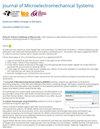Suspended Insulation Structure Design for Infrared Thermal Detector
IF 3.1
3区 工程技术
Q2 ENGINEERING, ELECTRICAL & ELECTRONIC
引用次数: 0
Abstract
Infrared thermal detectors generate signal output utilizing thermal effect, with detection performance being dictated by the structure design of the detector. To ensure effective thermal insulation, detectors are typically designed with slender supporting beams to reduce thermal conductivity and enhance signal output. In this paper, a fluorescent infrared detector with different isolation beam designs is proposed to investigate the trade-off relationship among detector performance parameters. Two kinds of isolation beams are theoretically derived to minimize the thermal conductivity for specific detection unit, and the thermal detectors with suspending units are manufactured by MEMS technology. The thermal imaging results for a 623 K heat source indicate that the temperature rise for the two-beam structure (i.e. 46.7 K) exceeds that of the four-beam structure (i.e. 38.3 K). Additionally, the detectivity of红外热探测器悬吊式保温结构设计
红外热探测器利用热效应产生信号输出,其探测性能取决于探测器的结构设计。为了确保有效的隔热,探测器通常设计有细长的支撑梁,以减少热导率和增强信号输出。本文提出了一种具有不同隔离光束设计的荧光红外探测器,研究了探测器性能参数之间的权衡关系。从理论上推导了两种隔离光束,以最小化特定探测单元的热导率,并利用MEMS技术制造了带有悬浮单元的热探测器。623 K热源的热成像结果表明,双束结构的温升(46.7 K)高于四束结构的温升(38.3 K),探测率为$4.05\乘以10^{\mathbf {7}}$ cm $\cdot $ Hz $ {\mathbf {1/2}}$ /W,低于四束结构的探测率($5.80\乘以10^{\mathbf {7}}$ cm $\cdot $ Hz $ {\mathbf {1/2}}$ /W)。计算并比较了时间分辨率和NETD。研究结果表明,在设计热探测器时,在可接受的范围内故意牺牲一部分探测性并降低光束导热系数可以显著提高温升并增加信号输出。(2024 - 0131)
本文章由计算机程序翻译,如有差异,请以英文原文为准。
求助全文
约1分钟内获得全文
求助全文
来源期刊

Journal of Microelectromechanical Systems
工程技术-工程:电子与电气
CiteScore
6.20
自引率
7.40%
发文量
115
审稿时长
7.5 months
期刊介绍:
The topics of interest include, but are not limited to: devices ranging in size from microns to millimeters, IC-compatible fabrication techniques, other fabrication techniques, measurement of micro phenomena, theoretical results, new materials and designs, micro actuators, micro robots, micro batteries, bearings, wear, reliability, electrical interconnections, micro telemanipulation, and standards appropriate to MEMS. Application examples and application oriented devices in fluidics, optics, bio-medical engineering, etc., are also of central interest.
 求助内容:
求助内容: 应助结果提醒方式:
应助结果提醒方式:


